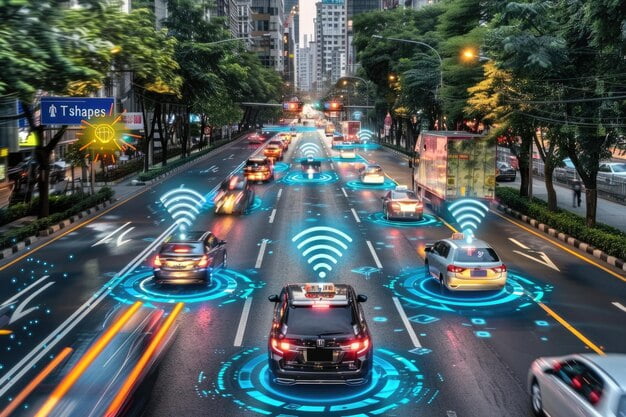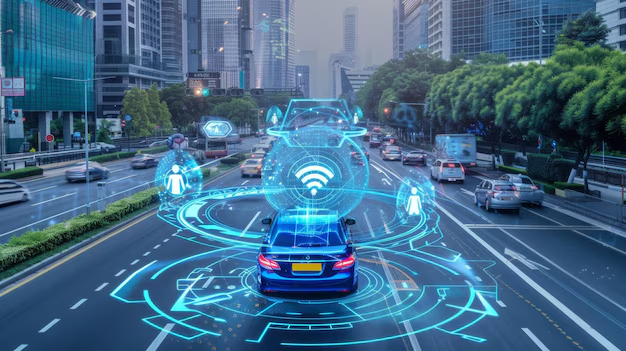Autonomous vehicles (AVs) represent one of the most transformative advancements in modern transportation. Equipped with advanced technologies such as sensors, cameras, radar, and lidar, these vehicles have the potential to revolutionize how we travel, enhancing safety, efficiency, and convenience on the roads. Central to the successful operation of autonomous vehicles is the integration of wireless networking technologies.
Wireless networking plays a crucial role in enabling the complex communication and data exchange required for AVs to operate seamlessly. From coordinating with other vehicles and infrastructure to processing real-time data for navigation and safety, wireless technology is the backbone that supports and enhances autonomous driving capabilities.
As autonomous vehicles become more prevalent, understanding the role of wireless networking becomes increasingly important. This blog explores how various wireless networking technologies contribute to the functionality and advancement of autonomous vehicles, highlighting their benefits, challenges, and future developments. We will delve into the core technologies behind AVs, the wireless networks that support them, and how these technologies work together to create a safer and more efficient driving experience.

Wireless Networking Technologies Supporting Autonomous Vehicles
Autonomous vehicles (AVs) rely heavily on wireless networking technologies to operate effectively and safely. These technologies facilitate real-time communication between vehicles, infrastructure, and other entities, enabling seamless operation and interaction within a complex transportation ecosystem. Here’s a detailed look at the key wireless networking technologies that support autonomous vehicles:
1. Vehicle-to-Everything (V2X) Communication
1.1. Definition and Components: Vehicle-to-Everything (V2X) communication encompasses various sub-technologies designed to improve vehicle connectivity and safety. It includes:
- Vehicle-to-Vehicle (V2V): Allows vehicles to communicate directly with each other, sharing information about speed, direction, and location. This helps in collision avoidance, lane change assistance, and improving overall traffic flow.
- Vehicle-to-Infrastructure (V2I): Enables vehicles to interact with road infrastructure such as traffic lights, road signs, and signals. This communication can help in optimizing traffic signal timings and providing real-time updates about road conditions or construction.
- Vehicle-to-Pedestrian (V2P): Facilitates communication between vehicles and pedestrians, typically through mobile apps or wearable devices. This technology enhances pedestrian safety by alerting drivers to the presence of pedestrians and vice versa.
1.2. Benefits: V2X communication enhances vehicle awareness, improves safety, and optimizes traffic management by providing timely and accurate information about surrounding conditions. For instance, V2V can help prevent collisions by alerting drivers about vehicles that are about to make sudden maneuvers, while V2I can improve traffic efficiency by synchronizing traffic lights with vehicle flow.
2. Cellular Network Technologies
2.1. 4G LTE: Long-Term Evolution (LTE), also known as 4G, was a significant step forward in mobile network technology, providing faster data speeds and lower latency compared to previous generations. While it is adequate for many applications, its capabilities are often surpassed by newer technologies.
2.2. 5G: 5G technology introduces substantial improvements in speed, latency, and capacity. Key features of 5G relevant to autonomous vehicles include:
- High-Speed Data Transfer: With speeds reaching up to 10 Gbps, 5G enables rapid data exchange between vehicles and the cloud, supporting real-time processing of high-definition video feeds and sensor data.
- Ultra-Low Latency: 5G’s low latency (as low as 1 millisecond) is crucial for applications requiring instant responses, such as collision avoidance and real-time decision-making.
- Massive IoT Connectivity: 5G supports the connection of a vast number of devices simultaneously, which is essential for the extensive network of sensors and communication nodes required in smart cities and autonomous vehicle ecosystems.
2.3. Benefits: 5G enhances the performance of autonomous vehicles by providing faster data transmission, supporting high-bandwidth applications, and enabling real-time communication with other vehicles and infrastructure. This allows AVs to react promptly to changing road conditions, making driving safer and more efficient.
3. Dedicated Short-Range Communications (DSRC)
3.1. Explanation of DSRC: Dedicated Short-Range Communications (DSRC) is a wireless communication technology specifically designed for vehicular communication. Operating in the 5.9 GHz band, DSRC enables vehicles to exchange information over short distances (up to 1,000 meters) with low latency.

3.2. Benefits and Limitations:
- Benefits: DSRC supports vehicle-to-vehicle (V2V) and vehicle-to-infrastructure (V2I) communication, making it suitable for safety-critical applications like collision warnings, emergency vehicle notifications, and traffic signal timing adjustments.
- Limitations: While DSRC offers reliable short-range communication, it has limitations in terms of data transfer speeds and range compared to newer technologies like 5G. Its deployment is also constrained by regulatory and infrastructure challenges.
4. Future Directions and Innovations
4.1. Integration with Emerging Technologies: As autonomous vehicles evolve, integrating wireless networking technologies with advancements in artificial intelligence (AI) and machine learning (ML) will further enhance their capabilities. AI-driven systems can analyze vast amounts of data from wireless networks to optimize vehicle performance and safety.
4.2. Potential of 6G: Looking ahead, the advent of 6G technology promises even greater improvements in connectivity and performance. With potential speeds up to 1 Tbps and enhanced capabilities for immersive applications, 6G could revolutionize how autonomous vehicles communicate and interact with their environment.
Wireless networking technologies are foundational to the operation and advancement of autonomous vehicles. By enabling real-time communication and data exchange, these technologies facilitate safer, more efficient, and intelligent transportation systems, paving the way for a future where autonomous driving becomes an integral part of our daily lives.
Key Benefits of Wireless Networking for Autonomous Vehicles
Wireless networking is a cornerstone of modern autonomous vehicle (AV) technology, providing crucial support for the complex systems that enable self-driving cars to navigate safely and efficiently. Here’s an in-depth look at the key benefits of wireless networking for autonomous vehicles:
1. Enhanced Safety and Collision Avoidance
1.1. Real-Time Communication: Wireless networking facilitates real-time communication between autonomous vehicles and other entities, including other vehicles, traffic infrastructure, and pedestrians. This constant exchange of information is vital for collision avoidance. For example, Vehicle-to-Vehicle (V2V) communication can alert a vehicle about a sudden stop or dangerous maneuver by another vehicle, allowing it to take preventive action promptly.
1.2. Situational Awareness: By using wireless networks to gather and share data from various sensors and sources, autonomous vehicles can achieve a higher level of situational awareness. This includes understanding the position of nearby vehicles, detecting road hazards, and responding to changes in traffic signals or road conditions. Enhanced situational awareness reduces the likelihood of accidents and improves overall road safety.
2. Improved Traffic Flow and Efficiency
2.1. Optimized Traffic Management: Wireless networking enables communication between vehicles and traffic infrastructure (Vehicle-to-Infrastructure, or V2I). This interaction allows for real-time adjustments to traffic signals and congestion management. For instance, vehicles can receive information about upcoming traffic lights and adjust their speed to avoid unnecessary stops, leading to smoother traffic flow and reduced travel times.
2.2. Dynamic Route Optimization: Autonomous vehicles equipped with wireless networking can access real-time traffic data and adjust their routes accordingly. This capability helps in avoiding congested areas, road closures, or accidents, leading to more efficient travel and reduced fuel consumption. Additionally, dynamic route optimization helps in better managing the overall traffic load on roadways.
3. Seamless Navigation and Mapping
3.1. Real-Time Data Updates: Wireless networking allows autonomous vehicles to continuously receive updates on road conditions, construction zones, and other relevant information. This real-time data helps in accurate navigation and ensures that the vehicle’s mapping system is up-to-date, reducing the risk of errors and enhancing navigation accuracy.
3.2. Integration with Advanced Mapping Systems: Wireless technology supports the integration of autonomous vehicles with advanced mapping systems that provide detailed and current information about roadways, obstacles, and traffic conditions. These systems enable vehicles to make informed decisions and navigate complex environments with greater precision.
4. Remote Monitoring and Updates
4.1. Over-the-Air (OTA) Updates: Wireless networking enables remote monitoring and maintenance of autonomous vehicles through Over-the-Air (OTA) updates. Manufacturers can deploy software updates and patches directly to vehicles, ensuring that they have the latest features, security enhancements, and performance improvements without requiring a physical visit to a service center.
4.2. Diagnostic Capabilities: Real-time wireless communication allows for continuous monitoring of a vehicle’s systems and performance. This capability facilitates remote diagnostics and troubleshooting, enabling quick identification of potential issues and minimizing downtime. It also supports proactive maintenance by alerting vehicle owners or fleet operators to necessary repairs or service.
5. Enhanced User Experience
5.1. In-Vehicle Connectivity: Wireless networking enhances the overall user experience by providing connectivity for in-vehicle entertainment, navigation, and communication systems. Passengers can enjoy seamless access to internet services, streaming content, and real-time information while traveling, making the journey more enjoyable and productive.
5.2. Integration with Smart Infrastructure: Autonomous vehicles can interact with smart infrastructure elements, such as smart traffic lights and parking management systems, through wireless networking. This integration allows for more efficient parking, smoother traffic flow, and better coordination with other smart city initiatives, contributing to a more connected and responsive transportation environment.
6. Support for Emerging Technologies
6.1. Integration with AI and ML: Wireless networking facilitates the integration of artificial intelligence (AI) and machine learning (ML) algorithms in autonomous vehicles. These technologies analyze data from various sources to make real-time decisions, improve driving behavior, and enhance overall vehicle performance.
6.2. Future-Ready Communication: As autonomous vehicles evolve, the ability to support future advancements in wireless communication, such as 6G, will further enhance their capabilities. Future wireless technologies promise even greater speeds, lower latency, and more robust connectivity, enabling even more sophisticated and reliable autonomous driving systems.
Future Developments and Trends
The landscape of autonomous vehicles (AVs) and wireless networking is rapidly evolving, driven by technological advancements and the increasing demand for more sophisticated and connected transportation solutions. Here’s a look at the future developments and trends shaping the role of wireless networking in autonomous vehicles:
1. Evolution of Wireless Technologies
1.1. Emergence of 6G: As we approach the era of 6G, the next generation of wireless technology promises to revolutionize connectivity even further. Expected to deliver speeds up to 1 terabit per second (Tbps) and latency as low as 0.1 milliseconds, 6G will offer unprecedented levels of data transfer and responsiveness. This will enable AVs to handle vast amounts of data in real-time, improving decision-making processes, safety features, and overall vehicle performance.
1.2. Terahertz Communication: Terahertz (THz) communication, a key component of 6G, will play a crucial role in achieving ultra-fast wireless communication. THz frequencies can support extremely high data rates and bandwidth, making them ideal for applications requiring massive data throughput, such as real-time HD video streaming and complex sensor data processing in AVs.
2. Integration with Artificial Intelligence (AI) and Machine Learning (ML)
2.1. AI-Driven Decision Making: The integration of AI and machine learning with wireless networking will enhance the capability of autonomous vehicles to process and analyze data. AI algorithms will leverage real-time data from wireless networks to make more accurate driving decisions, improve predictive maintenance, and optimize route planning based on dynamic traffic conditions.
2.2. Enhanced Perception and Navigation: Machine learning models will improve the perception and navigation systems of AVs by analyzing large datasets from various sensors and communication sources. This will lead to more precise object detection, better navigation in complex environments, and the ability to adapt to changing road conditions and traffic patterns.
3. Advanced V2X Communication
3.1. Expansion of V2X Capabilities: Future developments in Vehicle-to-Everything (V2X) communication will expand the range and functionality of interactions between vehicles, infrastructure, and pedestrians. Enhanced V2X systems will include more sophisticated communication protocols, increased coverage, and integration with emerging smart infrastructure components, contributing to more cohesive and responsive transportation networks.
3.2. Intersection of V2X and 5G/6G: The convergence of V2X communication with 5G and future 6G technologies will further enhance the effectiveness of vehicle communication systems. Ultra-low latency and high-bandwidth capabilities will enable more robust and reliable V2X interactions, improving vehicle coordination, traffic management, and overall safety.
4. Development of Smart Infrastructure
4.1. Smart Roadways and Traffic Management: The future of autonomous vehicles will be closely linked with the development of smart infrastructure. Smart roadways equipped with sensors and wireless communication capabilities will provide real-time data to AVs, helping them navigate more effectively and respond to dynamic traffic conditions. Advanced traffic management systems will use data from AVs to optimize traffic flow, reduce congestion, and improve overall road safety.
4.2. Integration with Urban Mobility Solutions: Autonomous vehicles will increasingly integrate with other urban mobility solutions, such as electric scooters, bicycles, and public transportation. Wireless networking will enable seamless communication between different modes of transportation, facilitating efficient multimodal transit options and enhancing the overall urban mobility experience.
5. Focus on Security and Privacy
5.1. Enhanced Security Measures: As autonomous vehicles become more connected, ensuring the security of wireless networks and communication systems will be paramount. Future developments will include advanced encryption methods, secure communication protocols, and robust authentication mechanisms to protect against cyber threats and unauthorized access.
5.2. Privacy Protection: The collection and transmission of data in autonomous vehicles will raise privacy concerns. Future trends will focus on implementing privacy-preserving technologies and data anonymization techniques to protect users’ personal information while still enabling the benefits of connected vehicle systems.
6. Collaboration and Standardization
6.1. Industry Collaboration: The advancement of wireless networking in autonomous vehicles will require collaboration among industry stakeholders, including vehicle manufacturers, technology providers, and regulatory bodies. Joint efforts will focus on developing common standards, protocols, and frameworks to ensure interoperability and compatibility across different systems and technologies.
6.2. Regulatory and Policy Development: As autonomous vehicles and wireless technologies continue to evolve, regulatory and policy frameworks will need to adapt. Future developments will involve creating comprehensive regulations that address safety, security, and ethical considerations while supporting innovation and the deployment of new technologies.
Conclusion
Wireless networking is a fundamental enabler of autonomous vehicle (AV) technology, providing the connectivity and data exchange needed for safe, efficient, and intelligent transportation. As we have explored, the key benefits of wireless networking for AVs include enhanced safety through real-time communication, improved traffic flow and navigation, seamless remote monitoring and updates, and an enriched user experience.
Looking ahead, the future developments in wireless networking, such as the advent of 6G and advanced V2X communication, will further revolutionize the autonomous driving landscape. Integration with artificial intelligence (AI) and machine learning (ML) will enable more sophisticated decision-making and adaptive systems, while smart infrastructure and urban mobility solutions will create a more interconnected and responsive transportation ecosystem.
However, with these advancements come challenges, particularly concerning security, privacy, and the need for standardized protocols. Addressing these issues will be crucial to ensuring the successful and widespread adoption of autonomous vehicles.
As wireless networking technologies continue to evolve, they will play a pivotal role in shaping the future of mobility. By supporting the development of smarter, safer, and more efficient transportation systems, wireless networking will be at the heart of the autonomous vehicle revolution, driving us towards a future where autonomous driving becomes an integral and transformative part of our daily lives.












